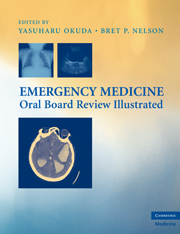Book contents
- Frontmatter
- Contents
- Contributors
- 1 How to Use This Book
- 2 EM Medical Decision Making
- 3 About the Oral Boards: The Approach and Practical Tips
- CASES
- Appendix A The Chest Pain Patient: Five Life-Threatening Causes and Critical Actions
- Appendix B The Confused Patient: Ten Most Common Causes and Critical Actions
- Appendix C The Poisoned Patient: Most Common Toxidromes and Treatments
- Appendix D The Trauma Patient: The Approach and Important Principles
- Appendix E Advanced Cardiac Life Support Review
- Appendix F Pediatric Pearls: High-Yield Facts from Fever to Drugs
- Appendix G Twenty Common Emergency Medicine Procedures: Indications, Contraindications, Technique, and Complications
- Appendix H Image Answer Key
- Index
- Plate section
2 - EM Medical Decision Making
Published online by Cambridge University Press: 04 August 2010
- Frontmatter
- Contents
- Contributors
- 1 How to Use This Book
- 2 EM Medical Decision Making
- 3 About the Oral Boards: The Approach and Practical Tips
- CASES
- Appendix A The Chest Pain Patient: Five Life-Threatening Causes and Critical Actions
- Appendix B The Confused Patient: Ten Most Common Causes and Critical Actions
- Appendix C The Poisoned Patient: Most Common Toxidromes and Treatments
- Appendix D The Trauma Patient: The Approach and Important Principles
- Appendix E Advanced Cardiac Life Support Review
- Appendix F Pediatric Pearls: High-Yield Facts from Fever to Drugs
- Appendix G Twenty Common Emergency Medicine Procedures: Indications, Contraindications, Technique, and Complications
- Appendix H Image Answer Key
- Index
- Plate section
Summary
This chapter discusses the cognitive processes of emergency medicine (EM). It is applicable to our approach in the department and to the more artificial environment of the board exam. Decision making in EM is quite different than most of the other fields in medicine. The novice may assume that we make most of our decisions using conscious contemplation, perhaps because this is the path the novice is forced to take. The reality is that if we had to think about every diagnosis and treatment during the course of a shift, we would be crushed under the cognitive load. Imagine for a moment how effortlessly you walk or speak; would these be as easy if you were consciously guiding each muscle contraction?
ILLNESS SCRIPTS
Thinking is the last resort; it is slow, and counterintuitively, predisposes us to error. Most of our decisions are made by pattern matching. Using only a few lines from the patient's history, a brief physical examination, some basic tests, like the glucose level, and most importantly a gestalt impression of how the patient looks, we can usually narrow the differential to one or perhaps a couple of possibilities. The process takes only seconds. We match the patient's presentation to an accumulation of all of the similar presentations we have seen or read about throughout our careers; this accumulation is referred to as an illness script. It is only when we do not have an illness script to match with the patient in front of us that we are forced to resort to other decision-making techniques.
- Type
- Chapter
- Information
- Emergency Medicine Oral Board Review Illustrated , pp. 16 - 18Publisher: Cambridge University PressPrint publication year: 2009



